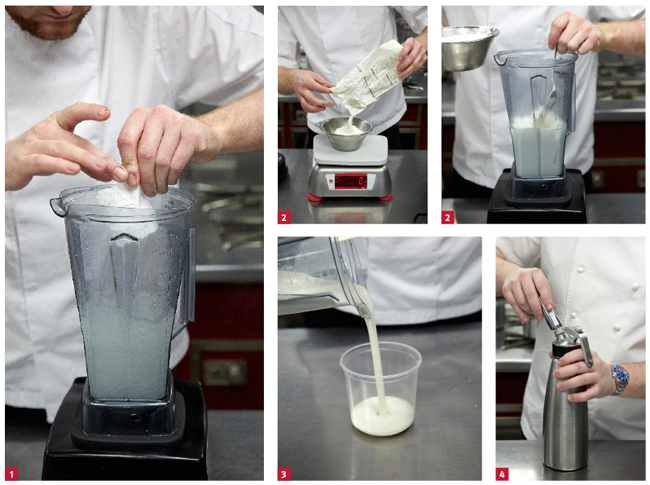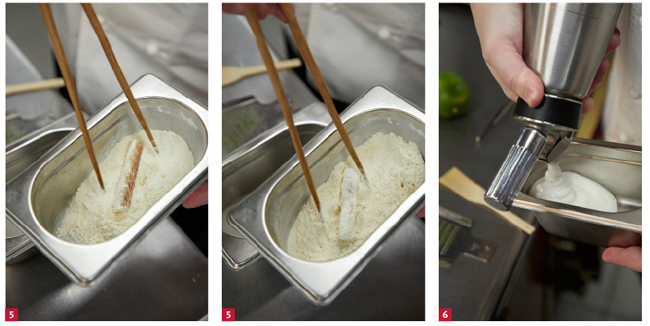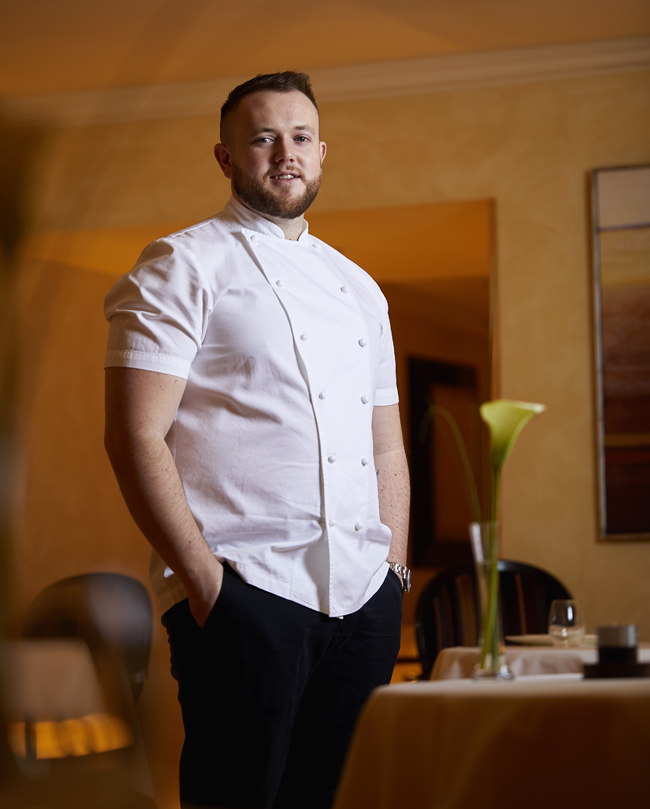Masterclass: tempura with Niall Keating
Niall Keating, executive head chef of Whatley Manor, has discovered the formula for perfect tempura, bringing new life to the Japanese favourite. Michael Raffael reports
Perfect tempura? It has to be crisp to the point of being brittle, it should never be greasy, and the coating should be fine enough to be transparent. Pointing out the basics isn't difficult, but a quick YouTube trawl is an eye-opener. Even Japanese tempura masters have their own individual, quirky techniques, and no two methods are identical.
At Whatley Manor in Malmesbury, Wiltshire, Niall Keating has reworked the tempura concept (perhaps inspired by a year working at San Francisco's Benu). Gone is the mixing bowl with chilled batter, and gone is the constraint of having to dish up fried food within seconds of it leaving the wok. In its place he has evolved a technique based around precise measurements that is practical and foolproof.
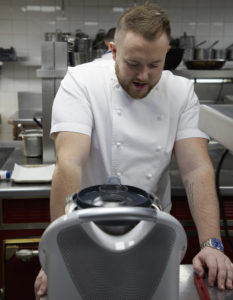
Perhaps the biggest advantage of his method is a practical one. Tempura chefs have to manage the batter while it fries. They move the product to the edges of the wok, skimming off batter bits or pressing them against the frying ingredients. But Keating's version doesn't leave beads of batter flotsam on the hot oil.
Planning
Tempura is one of four snacks served as two pairs on the Whatley Manor Dining Room's 14-course, £110 tasting menu.
The batter is made in advance and chilled ahead of service. Sweet and sour stock syrup is also prepared ahead. Each portion is two pieces and is fried to order. The oil is fresh to start with, but the chef may change it halfway through a busy (30 covers-plus) service because the tempura's colour shouldn't be golden.
The tempura is served hot and should go directly from frying to the pass and onto the customer's table.
Costing
At Whatley Manor, the food and beverage costs are integrated within the hotel's operating budget. Keating costs individual dishes, but he says that he's not under pressure as long as the kitchen contributes to the hotel's 27% gross profit target.
Tempura batter base
The batch size is for two one-litre espuma siphons, which is enough to batter about 60 pieces, depending on their size and surface area (see ‘Tempura variations' panel).
Equipment • Vita-Prep blender (2-litre capacity)
• 2 siphons
Ingredients • 4g xanthan gum
• 1 litre cold tap water
• 22g table salt
• 8g Ajinomoto (MSG)
• 195g rice flour
• 315g cornstarch
Put the xanthan gum and water in the Vita-Prep and blend for about 30 seconds (1).
Add the other ingredients and continue blending until the mixture is smooth and lightly emulsified (2).
Pour into two espuma siphons. Seal and shake well (3).
Load two gas cartridges for each siphon and charge. Chill ahead of use (4).
Smoked eel tempura Serves 1
• Frying oil (about 2 litres)
• Two 5cm fingers oak-smoked eel fillet
• Tempura batter
• Cornflour
• Sweet and sour citrus stock syrup
• Grated lime zest
Prepare a mini workstation for frying the tempura. You need a bowl of sifted cornflour and another with the batter, and some tongs or chopsticks to dip the eel. You'll also want a tray with a clean cloth or kitchen paper, plus a small paintbrush, a bowl containing the sweet and sour citrus stock, and lime plus a fine grater.
Heat the oil to 170°C. If it's hotter than that, the batter may colour or form a tighter coating around the eel. If it's cooler than 170°C, it won't stick properly.
One by one, coat the pieces of smoked eel in cornflour and shake off any excess (5). Pipe enough tempura foam from the siphon into the bowl to cover the eel (6). Coat the eel in the tempura mixture (7).
Drop the eel into the hot oil (8). The batter will expand and become lacy. Fry for about four minutes until the batter is quite crisp.
Take out the pieces, shaking off any oil, and place them on the tray (9). Brush with stock syrup and grate lime zest over the top (10).
Sweet and sour citrus stock syrup
• 1 part lime juice
• 2 parts liquid glucose
• 1 part sugar
• 1 dried yuzu, added to the syrup and left in until the batch is used
Note on serving
Keating serves the two tempura eel on a raised dish with two pieces of turbot sashimi and nashi pear.
Almond tofu, Exmoor caviar
Japanese kaiseki, the traditional multi-course meal, has a growing influence on the way British chefs compose testing menus. These start with sakizuke snacks, followed by dishes reflecting the season's produce. Next comes a vegetable or tofu dish. At Whatley Manor, the tasting menu's first four courses (focused on fish) are followed by in-house almond milk tofu, served with a spoon of Exmoor caviar and a concentrated chicken consommé.
Ingredients for 24 tofu lozenges (25g each) • 0.8g xanthan gum
• 0.6g agar-agar
• 0.6g powdered locust bean
• 600g almond milk
• 10g miso paste
• 35g almond butter
Sift the xanthan, agar-agar and locust bean. Blend them with the remaining ingredients. Pour the mixture into the Thermomix. Heat to 100°C on a slow (4) speed. Pour into shallow tartlet tins and leave to set.
To serve, put a tofu lozenge in a small bowl with a heaped teaspoon of caviar on top. Pour a jug of consommé into the bowl in front of the customer.
Niall Keating's tempura variations
• Smoked eel (see recipe, following page)
• White crabmeat
• Sea urchin wrapped in sesame leaf
• Braised daikon
• Sea cucumber
Classic tempura
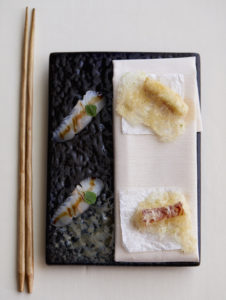
Today's tempura masters work with a batter made from iced water, flour and arrowroot (sometimes egg). The frying medium is a neutral oil; some sesame oil may be added.
In Japanese restaurants specialising in tempura, crispness and freshness are the main measures of quality. The customer receives their order within seconds, not minutes, of it leaving the wok. Accompanied with a dipping sauce based on mirin, soy and dashi, itâs very much a sharing experience.
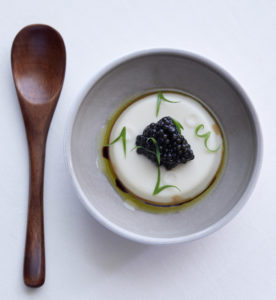
Exmoor caviar is produced from Siberian sturgeon, farmed on Exmoor, and itâs less salty and âfishyâ than the traditional Beluga, Sevruga or Oscietra varieties. Although itâs been on the market for only five years, it has a loyal following from chefs such as Nathan Outlaw and Michael Caines.
www.exmoorcaviar.com
Niall Keating
Technically savvy Niall Keating belongs to the post-molecular generation, which mixes and matches the old with the new. His CV highlights include working for Sat Bains and a year at San Franciscoâs three-Michelin-starred Benu, where he would have stayed had his visa not run out. He went there as a cook, he admits, and came back a chef.
âBefore I went to America I was struggling to decide what kind of food I wanted to produce. There I learned what a tasting menu is â" itâs more than just feeding guests, itâs taking them on a journey. It has to be timed. It has to be balanced. It has to be thought through in every detail.â
When he left he knew what path he wanted to take and his âyellow brick roadâ led him to Whatley Manor. There arenât many chefs who can come into a five-star Relais & Chateaux hotel with an established reputation for great food and ask to do just a tasting menu.
Whatley Manorâs general manager Sue Williams recognised his potential and gave him his head. âI was confident about my ability,â he says. âAnd because we had a second restaurant [the newly opened Greyâs Brasserie], guests or diners would always have a second option.â
Items on his menu have to bear his personal stamp, and they grow out of small ideas without any formal research and development. âItâs quite strange; I donât see a dish until itâs finished. Maybe, in one sense, it never is finished because itâs always evolving and changing into something else. You have to tweak things to stay relevant.â
He doesnât belong to the autocratic school of executive chefs. âEvery two weeks we have a project night. On a Sunday evening, we get together and more than anything we just talk. We discuss everything from ingredients to seasonality and the industry. Some of the young chefs are capable of producing outstanding food and it would be stupid of me not to harness their ability.â
In the short term, Keating, only 27, is intent on enjoying the âamazing opportunityâ heâs been gifted. He isnât stopping there, though. âIâm hungry for everything that can be gained in this industry.â



